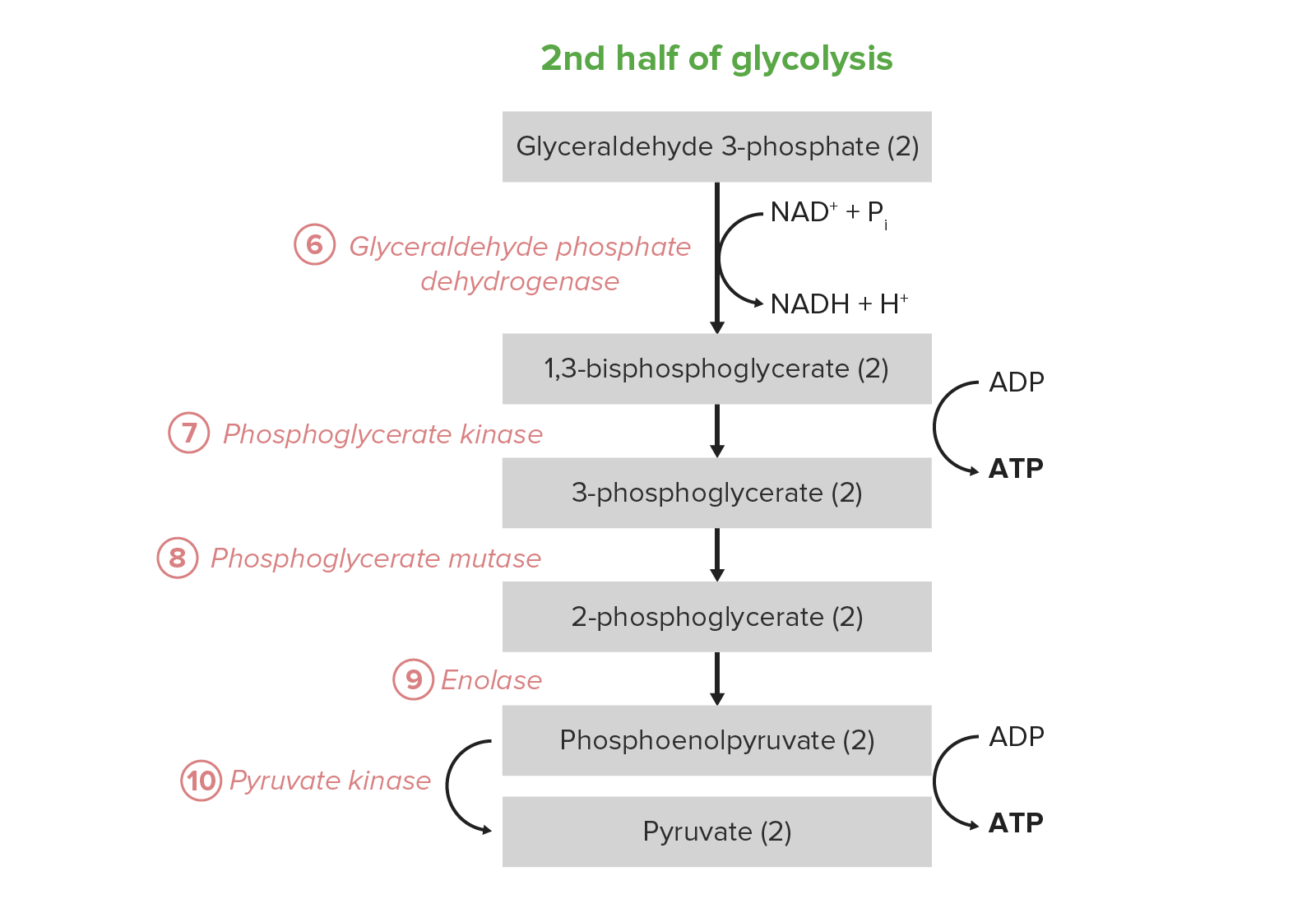Playlist
Show Playlist
Hide Playlist
Anaerobic Glycolysis
-
Slides 14 GlycolysisPyruvate oxidation CellBiology.pdf
-
Reference List Molecular and Cell Biology.pdf
-
Download Lecture Overview
00:01 There is no oxygen present or no oxygen necessary for glycolysis. 00:09 If there is oxygen present, we can continue on down into Krebs cycle and the oxidative piece of this puzzle. 00:17 But if there is no oxygen present, we have a little bit of a problem. 00:20 You may be aware that when we first begin exercise, we have not much oxygen in the tissues, and so we will produce a little bit of ATP. Glycolysis is fast, it's readily available to make some ATP. 00:35 But again, just a tiny bit of ATP. 00:38 In order to get more ATP in the absence of oxygen, we produce lactic acid in order to recycle those NAD cars so we can keep making ATP and glycolysis. Not much, but at least we can keep it going. 00:57 But lactic acid causes a few problems for us. You may have felt muscle soreness when you initially start to run up a stack of stairs. 01:05 So let's look at how this process works. 01:09 Again we have glucose, the process of glycolysis, we make some pyruvate. That's excellent. 01:14 We've got pyruvate. But there's no oxygen to drive the flow into Krebs cycle and oxidative phosphorylation and so we're at a standstill. 01:22 In order to recycle it, we need to make some lactate. We can recycle the NAD so that they can fuel the glycolysis. 01:30 There are two lactates produced per each glucose. This process is reversible such the little lactate can go back and form pyruvates and they can go on down into the Krebs cycle and oxidative phosphorylation. 01:47 This is a neat system that you'll cover in much more detail again in the biochemistry course. 01:53 You may cover it more in physiology also. 01:55 You've probably felt this in your body but the production of lactate has a number of different effects. 02:01 Firstly, it's important to understand that lactate and lactic acid are not the same. Lactate is the conjugate base of lactic acid, which is the form predominantly found in the body at physiological pH levels. 02:16 Contrary to common belief, recent literature suggests that lactate production itself is not the primary source of proton production that leads to acidosis. 02:27 Instead, it is believed that the hydrolysis of ATP is the main source of these protons. 02:33 These protons would normally be used in the mitochondrial process of oxidative phosphorylation. However, under anaerobic conditions, these protons are released into the cell and bloodstream. 02:46 This process can eventually overwhelm our body’s normal buffering system, resulting in a metabolic acidosis. The combination of hyperlactatemia and acidosis is what is medically referred to as lactic acidosis. 03:02 Once we decrease the pH, enzyme activity is slowed, and that's where we feel the muscle fatigue. 03:08 Things are literally getting slower in there and enzymes are not happy. 03:15 So yeast have a slightly different mechanism of dealing with this problem. 03:21 Yeast you probably know are not oxidative as in they cannot use oxygen to survive. 03:27 And so they have to recycle their NAD in a different fashion. Somehow they've got to get the taxis, the limousines empty so that they can continue glycolysis. 03:38 So the only reason that we have that lactic acid thing going on is because we need to continue glycolysis to have a little bit of energy being made in the form of ATP from glycolysis. 03:50 Yeast only have glycolysis for making energy. 03:53 Yeast undergo glycolysis in just the same way we do. They'll produce their pyruvates, two from each 6 carbon glucose. 04:02 And then in order to recycle the NADH taxis to keep glycolysis going and making ATP, they have to produce ethanol, which is a pretty neat reaction. 04:13 But the whole point is to recycle NADs so that they can continue to undergo glycolysis and yield a tiny bit of ATP and go about their cellular processes.
About the Lecture
The lecture Anaerobic Glycolysis by Georgina Cornwall, PhD is from the course Energy, Enzymes and Metabolism.
Included Quiz Questions
In the human body, pyruvate is converted to which molecule in the absence of oxygen?
- Lactate
- Oxaloacetate
- Acetyl-CoA
- Ethanol
- Glutamate
What are the effects of lactate build-up in muscle cells? (Select all that apply)
- Decrease in pH
- Muscle fatigue
- Decline in enzyme activity
- Increase in pH
- Increase in enzyme activity
Customer reviews
5,0 of 5 stars
| 5 Stars |
|
5 |
| 4 Stars |
|
0 |
| 3 Stars |
|
0 |
| 2 Stars |
|
0 |
| 1 Star |
|
0 |




